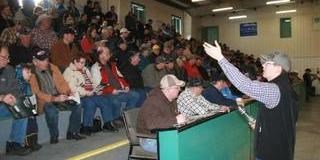It was interesting to walk into the ŌĆśBest of the BreedsŌĆÖ bull sale at Heartland Livestock in Yorkton recently and be busily taking a few pictures for the newspaper as the first bull sold on the day at $24,000.
IŌĆÖve covered agriculture in Yorkton for more than a quarter of a century now, so I have viewed a lot of bulls going under the gavel as I shot photographs. While I donŌĆÖt attend sales to watch every bull sell, I do get the reports after, and the price of the red angus to start that sale was as high as any I have witnessed in this area for years.
And Yorkton is not unique this spring. The top selling bull at the recent Medicine Hat Bull Sale was $35,000, and 73 Hereford bulls on offer averaged $9,023, while the 45 Angus bulls averaged $7,224.
Now I was attending Canadian Western Agribition with my Dad in that showŌĆÖs earliest years, and sat in the stands as some of the recent exotic cattle arrivals of the era, Simmental, Limousin and others brought prices in the range of thousands of dollars.
They were new breeds at that time offering producers to get in on the foundation development of those lines in Canada, so the prices were greatly influenced by the investment potential.
But the $24,000 this spring was different.
Yes it went to Wisconsin, where I suspect it will be used in a purebred operation, so genetics and investment were a factor, but at present high prices are also reflective of a cattle industry which is enjoying the highest prices in history.
The reason is rather straight forward, the North American cow herd is seeing some unbelievably low numbers, something speaker Sandy Russell with Spring Creek Consulting mentioned at the RBC Grain & Livestock Symposium which was part of last NovemberŌĆÖs Grain Millers Harvest Showdown in Yorkton.
Russell said statistics show the United States has ŌĆ£its smallest cow herd since 1954.
ŌĆ£WeŌĆÖre seeing unbelievably small numbers.ŌĆØ
And those numbers are going to be slow to rebuild.
On one hand there are still serious drought issues in cattle areas stretching from Texas to California, and that means even if the desire there is to grow numbers, conditions thwart such efforts.
Then there is the price factor for calves.
At an earlier stop at Heartland for a coffee and interview with an area cattleman, it was pointed out some 600-weight calves had hit $3/pound. Yes those were steers, but even when you back off that price a bit for heifers, the value is such that retaining them for the herd is not an easy decision. Calves have never been that highly valued before, so producers naturally want to grab those prices while they can.
For those choosing to seek out new females, prices are high. When you start to hear talk of $3000 bred heifers, it becomes costly to build herd numbers.
Granted the calf today would recoup a good chunk of the females cost, but one calf is not the story of the profit, or loss on any female.
It certainly appears prices will remain high through the current year. There are even some insurance style plans where profit laden prices can be locked in for this yearŌĆÖs calves, but prices in cattle are ever cyclical.
The current strong prices will not last forever, but in the next year or two things look as though the $24,000 price may not be that long before itŌĆÖs matched locally again.
Calvin Daniels is Assistant Editor of Yorkton This Week.


.JPG;w=120;h=80;mode=crop)

